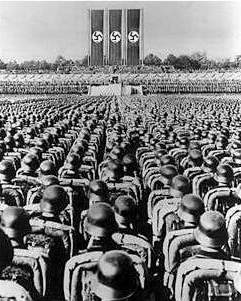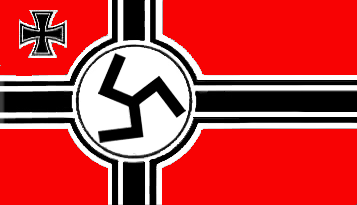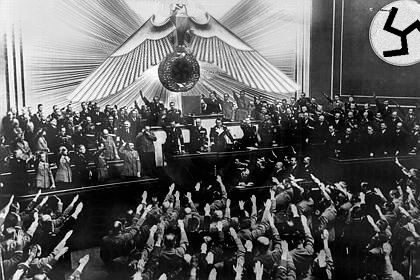The Imperial Race

| |
| Flag of The Imperial Race | |
| Motto: One people, one country, one leader '' | |
| http://upload.wikimedia.org/wikipedia/commons/thumb/c/cf/Map-deutsches-kaiserreich.png/200px-Map- | |
| Region | Pink Floyd |
|---|---|
| Capital | Berlin |
| Official Language(s) | German, |
| Leader | Kaiser Wilhelm II |
| Population | 862,000,000+ |
| Currency | Reichmark |
| NS Sunset XML | |
Contents
The Imperial Race
For the people see Imperials
The Imperial Race (TIR) is a nation that has been in turmoil recently. After the War in Pink Floyd the Imperial Race was a broken nation. Recently under Kasier Otto von Bismark The Imperial race has rebulit itself to its prewar status. Floydians and TIR are currently fighting in a Floydian Cold War. Palixia has described their nation to be "No better then Nazi Germany"
Founding of the Empire
Bismarck's founding of the Empire Under the guise of idealism giving way to realism, German nationalism rapidly shifted from its liberal and democratic character in 1848 to Prussian prime minister Otto von Bismarck's authoritarian Realpolitik. Bismarck wanted unification to achieve his aim of a conservative, Prussian-dominated German state. He accomplished this through three military successes:
1 He first allied with Austria in order to defeat Denmark in a short war (the Second war of Schleswig) fought during 1864, thus acquiring Schleswig-Holstein.
2.In 1866, in concert with Italy, he virtually created the Austro-Prussian War and won a decisive victory at the Battle of Königgrätz, which, in the same year, allowed him to exclude long-time rival Austria when forming the North German Confederation with the states that had supported Prussia in the Austro-Prussian War. The Confederation was the direct precursor to the 1871 Empire.
3. Finally, France was defeated in the Franco-Prussian War (1870–71); the Confederation was transformed into the Empire with the proclamation of Prussian King Wilhelm I as German Emperor at the Palace of Versailles, to the humiliation of the French. Bismarck himself prepared in broad outline the 1866 North German Constitution, to become the 1871 Constitution of the German Empire with some adjustments. Germany acquired some democratic features: notably the Reichstag, that in contrast to the parliament of Prussia was elected by direct and equal manhood suffrage. However, legislation also required the consent of the Bundesrat, the federal council of deputies from the states, in which Prussia had a large influence. Behind a constitutional façade, Prussia thus exercised predominant influence in both bodies with executive power vested in the Kaiser, who appointed the federal chancellor – Otto von Bismarck. While the minor states retained their own governments, the military forces were coordinated along Prussian principles and would in war times be controlled by the federal government. Although authoritarian in many respects, the empire permitted the development of political parties.
Proclamation of the German Empire in Versailles. Bismarck in white in the centre of the imageThe evolution of the authoritarian German Empire is somewhat in line with parallel developments in Italy and Japan. Similarly to Bismarck, Count Camillo Benso di Cavour in Italy used diplomacy and war to achieve his objectives: he allied with France before attacking Austria, securing the unification of Italy except for Venice and the Papal States by 1861. In the interests of Piedmont-Sardinia, Cavour, hostile to the more revolutionary nationalism of liberal republicans such as Giuseppe Garibaldi and Giuseppe Mazzini, sought the unification of Italy along conservative lines. Similarly, Japan would follow a course of conservative modernization from the fall of the Tokugawa Shogunate and the Meiji Restoration to 1918 along with Cavour's Italy. In fact, Japan issued a commission in 1882 to study various governmental structures throughout the world and were particularly impressed by Bismarck's Germany, issuing a constitution in 1889 that formed a premiership with powers analogous to Bismarck's position as chancellor with a cabinet responsible to the emperor alone.
The unification of Germany also meant absorbing the entire Kingdom of Prussia into it. The 3 provinces of East Prussia (75% German, 19% Polish/Mazurian, 5% Lithuanian), West Prussia (66% German, 33% Polish, including roughly 100.000 Kashubians), and Provinz Posen (62% Polish, 38% German), which before were outside the German Confederation, were incorporated into the new nation-state. Another province, Silesia (75% German, 25% Polish), historically part of the Holy Roman Empire together with Bohemia and unlike East Prussia, West Prussia and Provinz Posen part of the German Confederation had a large Polish population. Integration of these 4 provinces put Germany into conflict with the Poles. Since the Polish population was growing more rapidly, and Germans were migrating from eastern to western Germany in the Ostflucht, eastern provinces gradually become more and more Polish in character.
One factor, but only one, in the social anatomy of these governments had been the retention of a very substantial share in political power by the landed elite, the Junkers, due to the absence of a revolutionary breakthrough by the peasants in combination with urban areas.
Conservative modernization
War In Pink Floyd
Increased tensions with Tetris L-Shaped Block, forced the Imperial race to fight. After a coup in Pink Floyd The Imperial race set out to liberate the region. The after several days and several sleeper cells where placed in the region to observe activites. After several days peace came with the Fith peroiod Agreement.
Peace
Several days after peace with Pink Floyd, NationalCapilaism returned. this lead to the deaths of several thousand floydits and Imperialists
The Nagi Party (The National-Capialist Imperial Eliteist Party)
National-Capitalism is Facism of the Imperial race. It dominates all corners of The Empire and recently Imperials everywhere have formed terrorist movements to fight for it. the nations most greatly affected are those that fought against The Imperial race in the 4 Day War. Nagi comes from the first 4 letters of National. The T was droped and replaced with a g to honor George Pita
for more, see the full artical
Military
The military consists of 43,450,000 men. For a long time the Military was a soviet style force. but Pita made a massive switch. Blitzkerig Shall be used to eliminate all enemies. The Military focus on speed and airpower Military man power
Heer- 43,000,000 men. Standard Rilfe Heckler & Koch G36, And German Tanks.
Luftwaffe- 400,000 pilots. American and German Craft.Kriegsmarine- 50,000men. German Craft
Protective Squadron (Ps) - 5,000 men (divison of the Army)
Pita Youth- Nagi Boy Scouts
Church of Floyd and the Imperial race
In the Imperial race the Holy Church of Floyd has been allowed to resume. any person that attempts to worship them however, are subject to discrimination be Imperials and members of the Nagi Party. Esperanto has been viewed as a Floydist and has been outlawed.
World fact Book
GEOGRAPHY Climate- mostly temperate .
Terrain- Mainly, flat lands, forests and Mountains.
Natural resources- Massive oil and Uranium resverses. Many corperations use The Imperial race because there are little or no environmental laws and minumun wage laws.
Territoral Waters- 20 miles in all directions.
DEMOGRAPHICS
Population- 850 million
Age sturcture- 0-12 10%, 12-18 15%, 18-70 70%, 70 and above 5%
Life Expectancy- Male- 70, Female- 72
National Noun- Imperial
Races- 99% Imperial. 1% other
Religions- Nagi Church 99%, 1% Holy Church of Floyd
Literacy rate- 80%
Government
Formal Name- The Third Reich of the Imperial Race
Short name- The Imperial Race, The Third Reich
Goverment Type- Corperate Police State
Capital- Berlin
Adminstrative regions- 5
Independence from the "Socailist Oppressors"
November 4, 1999Chief of State- The Führer
Elections- N/A
Political Parties- National-Capitalist Impeial Eliteist Party 100%
Allies- serinistad, Neferamity,
Enemey states- Urscheler
Rivials- Socialist Freemen, Tetris L-Shaped Block
Laws- No minium wage, no trade unions, Holy Church of Floyd is outlawed, Esperanto is outlawed
Economy
Trade- Main training Partners Serenistad, Nefermaty, and Urscheler
Main Industry- Uranium Mining, Arms Manufacturing, and Door-to-door Insurance Sales industries
Currency- Reichmark
Laws- No minium wage, no trade unions, Holy Church of Floyd is outlawed, Esperanto is outlawed



